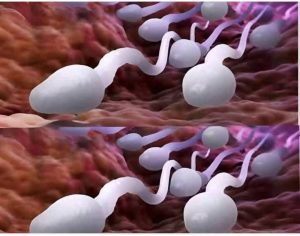🛑 Studies reveal that swallowing your partner’s semen…🛑 Studies reveal that swallowing your partner’s semen

1. Sperm Cells
The most prominent feature in the image is the depiction of several sperm cells.
They have the classic shape:
Oval head: This contains the nucleus with tightly packed DNA, representing the father’s genetic contribution.
Midpiece (not clearly shown): In real sperm, this contains mitochondria for energy, powering the tail’s movement.
Tail (flagellum): Used for propulsion, enabling the sperm to swim through the female reproductive tract.
The image shows them swimming in the same direction, reflecting the biological journey toward the egg (ovum).
2. Background Tissue
The reddish-brown and pink background mimics the inner lining of the female reproductive tract.
The folds and textures suggest a soft, organic environment, likely either:
The cervical canal (initial entry point for sperm),
The uterus, or most likely,
The fallopian tube, where fertilization typically occurs.
3. Magnification and Artistic Touch
The image exaggerates the size and spacing to highlight the features of sperm cells, which in real life are microscopic.
Lighting and shading make the sperm appear three-dimensional, giving a semi-realistic yet digital feel.
The colors used are naturalistic enough to be educational but vibrant enough to engage a general audience.
Scientific Significance: The Journey of Fertilization
This image represents a critical phase in human reproduction: sperm migration and fertilization.
The Pathway of Sperm:
Ejaculation and Cervical Entry:
During ejaculation, millions of sperm are deposited in the vagina.
Only a few thousand survive the hostile acidic environment and pass through the cervix into the uterus.
Uterine Navigation:
Sperm are guided by chemical cues (chemotaxis) and uterine contractions toward the fallopian tubes.
Final Race in the Fallopian Tube:
Of the initial millions, only a few hundred reach the vicinity of the egg.
Only one sperm cell will ultimately fertilize the egg.

Fertilization:
When a sperm penetrates the egg’s outer membrane, it triggers a chemical reaction that prevents other sperm from entering.
The genetic material from the sperm merges with that of the egg, creating a zygote, the first stage of a new human life.